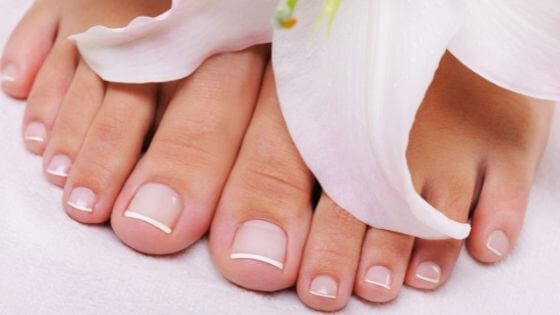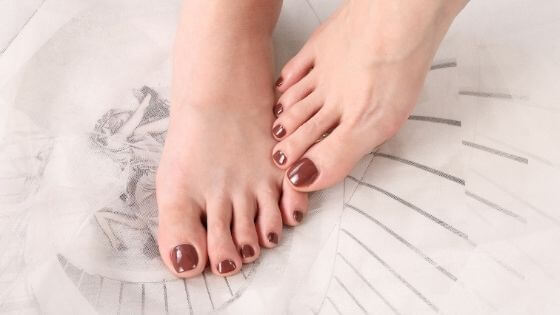How to do a Pedicure at Home Step by Step!

It's that time of year again where the weather starts to change, and we start thinking about putting our toes out for all to see. This is a great opportunity for us and those around us who might have missed seeing them last year. A pedicure can be an empowering experience, and it's important to take care of your feet before you show them off.
The best way to prepare your feet is with a foot scrub or exfoliating treatment followed by soaking in warm water mixed with Epsom salts. If you don't want any color on your nails, just let the nail polish dry and then dip your toes into some lemon juice or vinegar, so they're nice and clean when you put on some clear topcoat.
But pedicures do much more than make us feel good and look pretty. If you're not taking care of your feet, the pedicure process can help you with that, too.
What is a pedicure?

Pedicures are treatments of the feet and toenails, analogous to a manicure. Pedicures are done for cosmetic purposes but also as a therapeutic means. They're popular around the world, and pedicures include taking care not only of your nails; dead skin cells on the bottom of your feet are rubbed off with a rough stone.
The pedicure process generally includes soaking in water or other liquids such as oils, exfoliating with scrubbing particles (such as pumice) or a chemical solution (such as lactic acid), removing calluses or corns with an electric rotating file (a Pedi-course), trimming nails with nail clippers, cutting them into desired shapes (e.g., square), treating nails with urea-containing nail polish and a base coat, a nail strengthener such as gelatin, and cuticle care (including pushing back of the cuticles) using special cuticle scissors or cuticle nippers.
A pedicure often is a luxury that many people indulge in to relax. They go to day spas or visit their local pedicurists and have it done.
Why is pedicure important?
We may not realize it, but pedicures are critical to good health. They help prevent fungal infections in the feet that could lead to serious problems. These pedicure treatments can be performed by a medical pedicurist or at home.
Fungal infection of the nails is known as onychomycosis (commonly referred to as a nail fungus). It is characterized by changes in the appearance of the nails, including thickness and brittleness. Toenail infections are more common than those affecting fingernails. However, left untreated, it may cause permanent damage to the nail and surrounding tissue resulting in a loss of control of the affected body part.
Can pedicure help the ingrown toenail?
The pedicure process can really help someone who has ingrown toenails. An ingrown toenail is a nail that has grown into the flesh surrounding it. This causes pain, redness, and swelling.
This process can be very effective in preventing ingrown toenails from happening again. When you have it done after having an ingrown toenail, don't choose one that has a nail file or cuticle nipper on the pedicure set. Choose one that has a pumice stone or an electric rotating file instead. These tools will help you get rid of the dead skin on the bottom of your feet where the toenail had ingrown, preventing the toenail from causing pain again in the future.
Can pedicure remove calluses?
Another benefit is that it removes calluses. Sometimes your feet have hard skin on the bottom because you're either not using the correct foot products or wearing shoes that aren't comfortable.
When you get a pedicure, ask your pedicurist to use an electric rotating file to remove as much of the hard skin as possible. This pedicure tool will remove the dead skin on your foot that is hard and rough, but it's also gentle enough to use where you don't want to have any dry, dead skin removed. Then, when you get home and apply moisturizer to your feet, it will help keep moisture and prevent the hard skin from forming again.
Which pedicure is best?
There are pedicures in salons and pedicures that you can do at home.
A pedicure performed for 10-15 minutes by a pedicurist may cost you about $25, but it's worth the price, especially if you need it because of an ingrown toenail or your feet are dry and need attention.
At-home pedicures, performed for about 10 minutes with the pedicure kit that you can buy at drugstores or department stores, may cost you $10, but they don't provide the pedicurist experience. In addition, there is no time for soaking your feet in warm water and oils to soften your feet.
There is no nail technician to file down your dead skin on the bottom of your feet, and there is no pedicurist to give you a pedicure massage.
Your nails will be protected with foam strips, and your technician may start by applying a base coat depending on the type of polish you selected. You'll then receive two coats of color along with a top coat to create an elegant finish while also speeding up drying time!
A nail salon with all these benefits may be considered worth the extra cost compared to pedicures done at home. Still, pedicures performed in salons are the option providing the most pedicure benefits.
On the other hand, pedicures done at home are quick and easy to perform by yourself, and there is no need to leave your home or get ready for this treatment.
The choice you make depends on whether you want to spend some time in a pedicure salon or perform this treatment by yourself at home.
Its benefits are the same in both situations. In either case, pedicures can help keep your feet healthy and beautiful for years to come.
What is a spa pedicure?
A Spa Pedicure is a way to relax and rejuvenate your feet. The experience starts with a cleansing, exfoliating scrub that will remove any dead skin cells from both feet and between toes for softness.
This includes trimming nails, filing down rough edges of nails or cuticles then polishing them either in an acrylic finish (pretty) or just clear polish, which keeps it healthy by preventing injury while still being able to show off natural beauty underfoot when wearing sandals this summer season."
How to do a pedicure at home

A pedicure at home is the option that you are most likely to choose. This is because it's simple to perform on yourself, and there's no need to leave your home or get ready for treatment.
You can do a professional pedicure at home. Now I am telling you step by step how to do it properly at home.
1) Remove old polish
It only takes a few minutes to remove the polish off your nails with a cotton round or cotton pad and nail polish remover. If you don't have any, use a paper towel instead, but it will take some time because this material is less abrasive than cotton rounds, so that removal will require more elbow grease!
2) Soak your feet in warm water for 15 to 30 minutes
Soaking your feet in warm water will soften the skin on the bottom of your feet and reduce the possibility of developing pedicure problems like calluses or ingrown toenails.
A foot bath is a wonderful way to rejuvenate your tired feet. The bubbles and warmth will soothe any tension you may be feeling.
3) Use a pumice stone
The third step is using a pumice stone to remove dead skin from the bottom of your feet. Rub it gently against each foot until all the dead skin is gone. Next, rinse your feet with warm water to get rid of any dead skin that's still left on the bottom of your feet.
4) File down your rough skin areas
File down your rough, hard skin areas with pedicure tools such as pedicure foot files or pumice stones until they are smooth. Use a pedicure foot file or pumice stone to remove more of the dead skin on your feet if they're not smooth after pedicuring.
5) Use a pedicure lotion
Rub a pedicure lotion onto your feet and let it dry for a few minutes so that the pedicurist will stay in place longer. Rub pedicure lotions into your feet before pedicuring if they're dry or cracked. Some pedicures contain moisturizers that help keep your feet moist even after pedicuring. This benefit can prevent the development of ingrown toenails, calluses, and other problems.
6) Apply pedicure soak
Apply pedicure soak to your feet and allow it to sit on your pedicured feet for at least five minutes. These soaks are products that help to pedicure last longer and provide benefits like moisturizing dry skin.
7) Remove the pedicure soak with warm water
Remove the soak with warm water and. Rub your pedicured feet if they feel dry after pedicuring. The benefits these pedicure products provide are similar to the soaks you used in step six.
8) Moisturize your feet
Moisturize your feet gently with lotions or pedicure creams. Rub the pedicure cream onto your pedicured feet before you go to bed, or wash your pedicured feet if they do not feel moisturized enough.
9) Clean pedicure tools with pedicure cleaner
Clean pedicure tools with a cleaner before and after pedicuring to keep your products free from bacteria that may cause problems such as an infection or a rash. Pedicures can be performed using nail clippers, pumice stones, pedicure foot files, callus shavers, or toenail clippers. In addition, pedicures are often performed with lotions, soaks, creams, scrubs, or pedicurist pedicuring kits.
10) Put on socks at night
Put cotton socks on your pedicured feet at night and during the day when you wear sandals so that pedicures can last for as long as possible.
Conclusion
Pedicures are pedicure treatments for the feet and toenails. They include filing down rough skin areas, soaking in warm water before pedicuring, applying pedicure soaks or pedicure scrubs after pedicuring, and more.
If you want your pedicure to last as long as possible, you must follow these steps correctly every time. Otherwise, they may not work!
